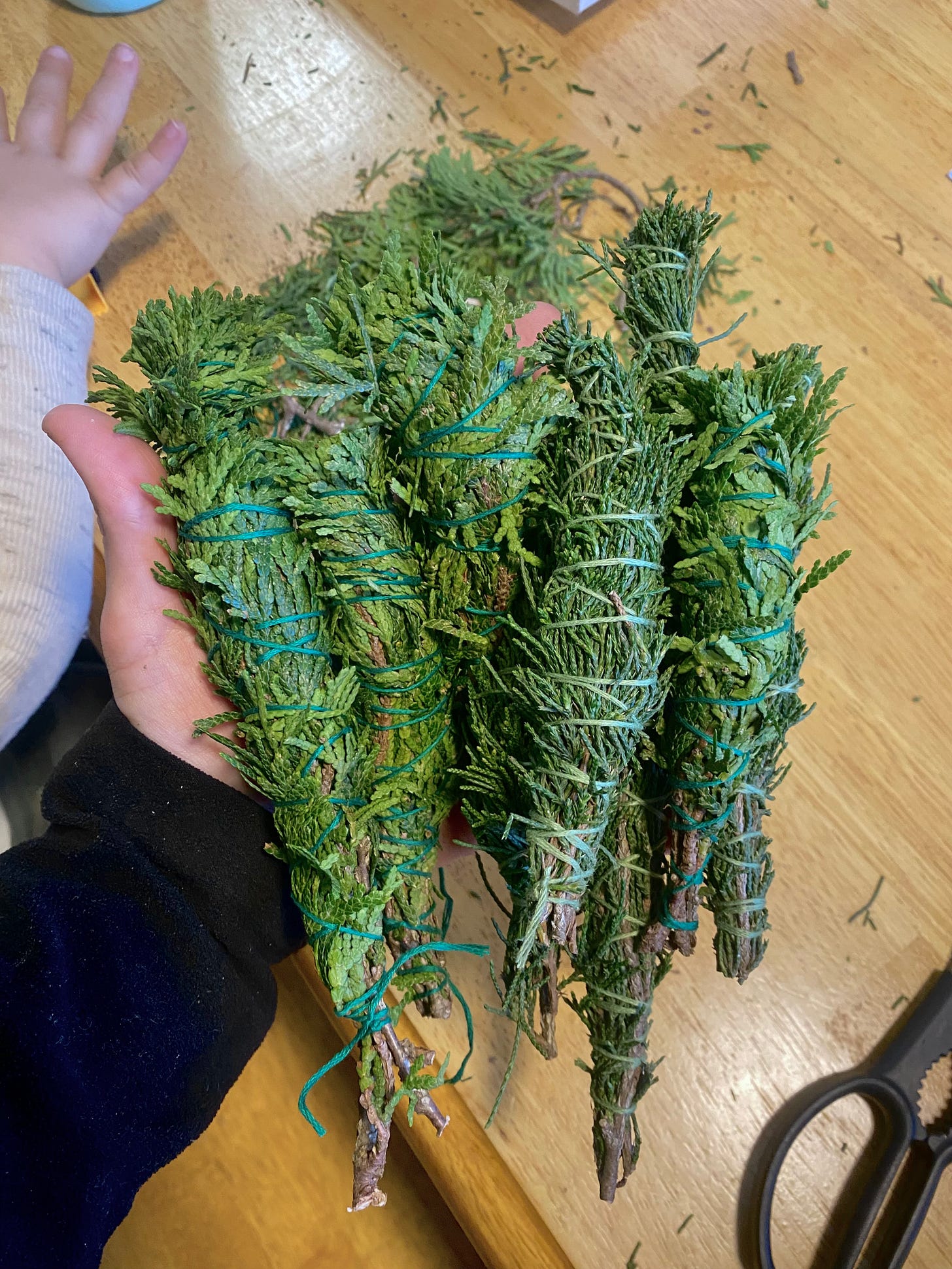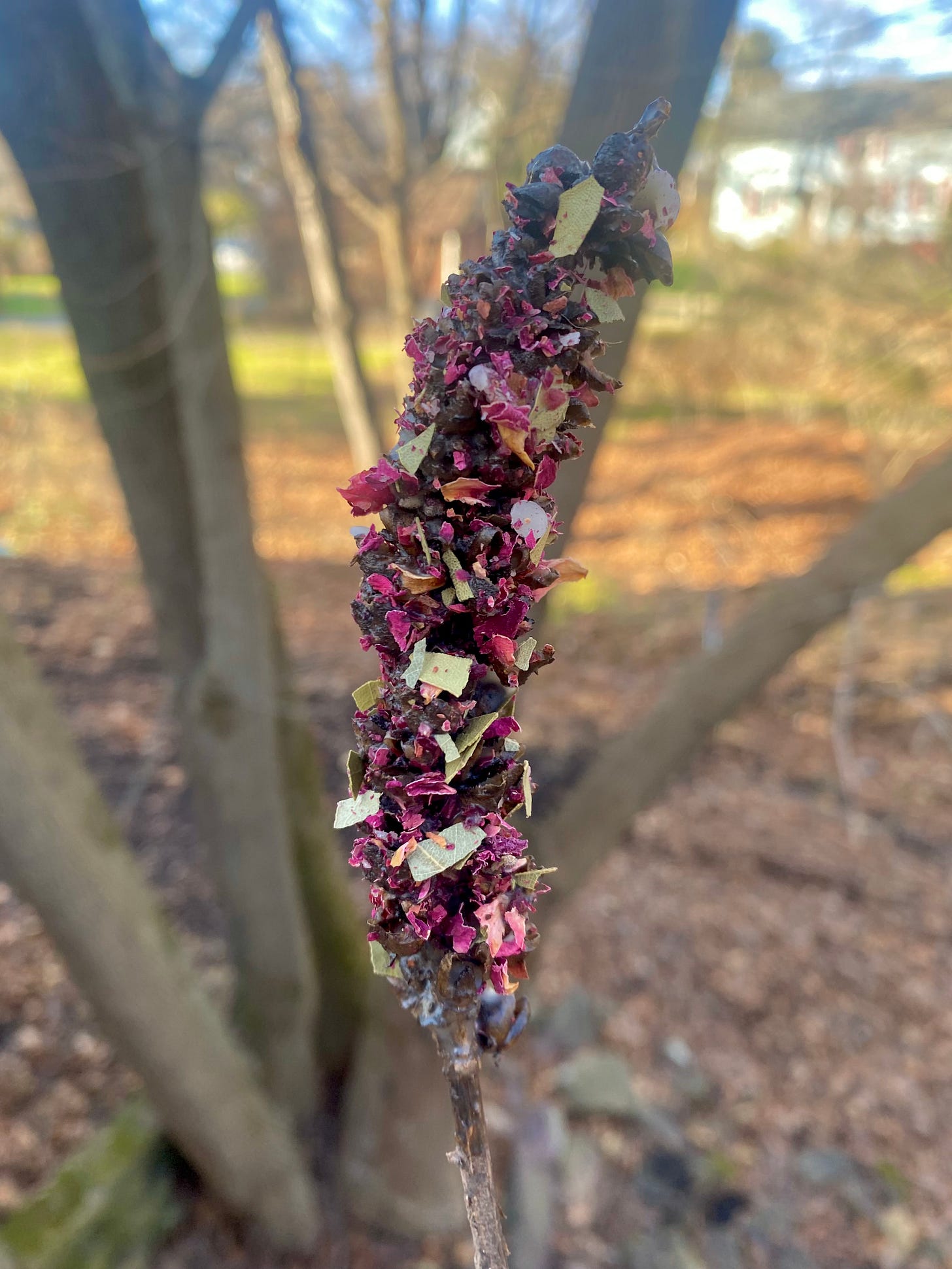
December 21st, a day of much cultural significance, is right around the corner. Numerology regards 1221 as an angel number signifying spiritual awakening and an opportunity to pursue your aspirations. It is the winter solstice in the Northern Hemisphere, the first day of winter, the shortest day of the year, the start of Yule, and the last day of Sagittarius season.
Winter itself does not appear to harbor much life at all. The lush greenery has long withered away, animals and insects have fallen silent, rain showers transform into blankets of snow. But for life in nature, this inhospitable weather simply signals a time to rest. So, while winter may widely lack the theater of flora and fauna, there are still many ancient traditions that we can practice to help us feel connected to the rhythm of nature. Here are some things I’ve been up to lately to do just that!
Pine Needle Tea
Winter is just about here in New Jersey. It is getting cold, and dark. This autumn has also been particularly damp. You are starting to feel run down, maybe heavy in your chest. You glance out the window, noticing a deep green beacon amidst the gray and brown landscape. Pine needles! Pine needles are rich in Vitamin C and have cooling/drying/astringent energetics- great for combating the physiological effects of cold and damp conditions. Pine needle tea is particularly soothing for those types of symptoms: chest congestion, sore throats, even depression. This is something that indigenous cultures have known for centuries. Isn’t it amazing that what’s available in nature is there right when you need it? Please note that some varieties of pine contain harmful toxins, so be sure to first positively identify an Eastern White Pine tree if you are even considering doing this.
Field NotesEastern White Pines may have particularly potent astringent properties. I first noticed this when comparing my foraged pine resin from South Jersey to foraged Pinyon Pine resin that I purchased from Utah, which has a sweeter, softer aroma (though the medicine is just as potent!).
Ingredients
A handful of fresh Eastern White Pine needles
—> (You can chop them up if you’d like, but it’s not necessary)
A handful of dried Chamomile flowers and Rose petals
A fresh lemon
A tablespoon of honey
Directions
Bring a couple cups of water to boil, then remove from heat. You don’t want to boil these ingredients, as it destroys the nutrient content. Drop in your Pine needles, Chamomile flowers, and Rose petals. Cover and let steep for up to 30 minutes. If I plan to steep longer and make a stronger cup of tea, I’ll put the pot on the warmer plate of my stove on Low. When steeped to your satisfaction, strain contents into a mug. Squeeze in a fresh lemon, stir in honey to taste, and sip hot. Enjoy!
Evergreen Cleansing Bundles
Winter is obviously all about the evergreens! Evergreens are amazing sources of life. Unique adaptations make them able to survive even the most inhospitable of conditions. There are many ancestral traditions from all over the world that attempt to harness and apply this energy.
Similar to smoke wands of Sage, evergreens can be bundled, dried, and burned for various spiritual and ritualistic purposes.
Popular evergreens to use for bundling include:
Juniper for cleansing and attracting positivity
Spruce for resilience and strength to overcome darkness
Pine for healing and attracting prosperity
Cedar for driving out negative energy
Cypress for peace and the wisdom to let go
How to…
Identify the evergreen of your choice. Clip or break off a handful of sprigs that are roughly the same length. Bundle in your hands and wrap tightly with organic cord (cotton, hemp, etc.). The bundles will shrink as they dry so you need to make sure you wrap the bundles as tightly as you can. Trim with scissors to clean up the appearance, if necessary. Hang upside down to dry out in a cool, dark place for 6 to 8 weeks. Mine will be ready just in time for my 33rd birthday, so I plan to use them then!
Mullein Torches
Mullein is a common medicinal plant that is mainly used against respiratory illnesses. The life of a single mullein plant is two years. It appears the first year as a huge, fuzzy basal rosette. After a nice winter rest, the Mullein will then grow a long stalk (up to 9 feet tall!), flower, spread its seeds, and die. Once the dead stalks have dried out, the tips can be harvested, dipped in wax or tallow, and set alight.
The use of Mullein torches dates back to Ancient Rome, where they were used to accompany funeral processions, illuminating the spirits in their path. They can also be covered in dried herbs and petals for additional intentional purposes.
I made three kinds:
Bay leaf & Rose petals for manifestation and love
Lavender & Chamomile flowers for peace and positivity
Clove & Calendula petals for good luck and healing
In certain schools of witchcraft, Mullein torches are referred to as Hag’s tapers, and are revered as having similar smoke cleansing properties to Sage. Hag’s tapers can be burned to clear negative energy, thin the veil between dimensions, and offer spiritual protection during rites.
I do not identify as a “witch”, but to honor this gift from nature and the ancestral traditions that have passed along this knowledge, I will light mine on December 21st- as a symbol of light and good blessings for the next year.
Field Notes
Don’t light these indoors unless you have enough room wherever you are to accompany a huge torch flame and somewhere for all the smoke to go.
How To…
Melt beeswax in a heat safe jar, double boiler style is easiest. When fully melted, dip in the Mullein stalks, coating the buds. If you are using dried herbs or petals, quickly sprinkle them on before the wax starts to dry. That’s it! Super easy. Check out my Instagram for a visual how-to video.
Lemon Balm Syrup
A couple weeks ago I discovered a beautiful Lemon Balm cascading out of a sea of dead Mugwort, deep in my backyard. Lemon Balm, like other members of the Mint family, is quite cold hardy. This plant had miraculously outlived its aggressive, more tender neighbors and was finally able to grab some sunshine and nutrients! I was happy for it.
At first, I thought it was just a lone Perilla. Perilla is also a member of the Mint family and grows wild all over the upper portions of our property. As I rubbed the leaves between my fingers I expected to be greeted by the strong, acrid aroma of Perilla. But I was pleasantly surprised to be greeted by a soft, lemony scent! What a sweet surprise. I cleared out some of the dead brush to give it more room to grow, and chose to celebrate by collecting a small harvest.
Lemon Balm has been used medicinally for centuries to improve mood, circadian rhythm, cognitive & digestive function. Despite its soft aroma, Lemon Balm is a potent plant medicine (one of the few that has been studied in a mainstream, clinical setting) with notable antibacterial, antifungal and antiviral properties. Lemon Balm is most commonly consumed as a tea, but you can also eat it raw, dry, tincture or use it topically.
Directions
Pack a glass jar of your desired size about half full with fresh Lemon Balm sprigs. Fill the jar the rest of the way with raw honey and stir, making sure all of the plant matter is covered. Flip the jar a few times a day. This will prevent mold from growing on the plant matter! After about 10 days your syrup will be ready. The sprigs are edible, but you can strain or pick them out if you’d like. Refrigerate and use within a month.







